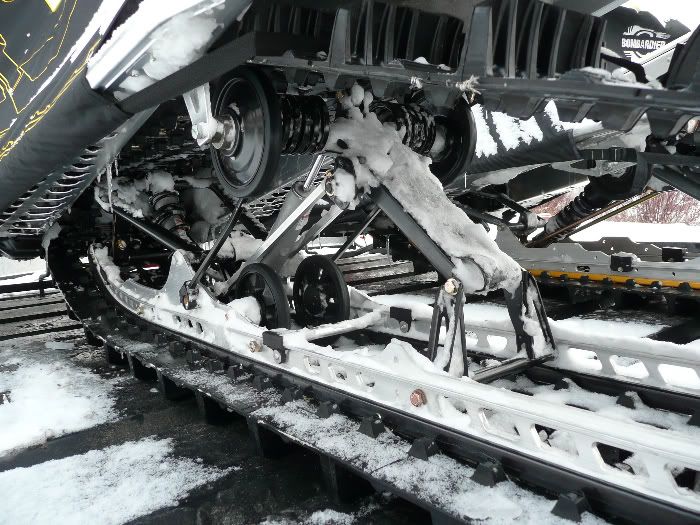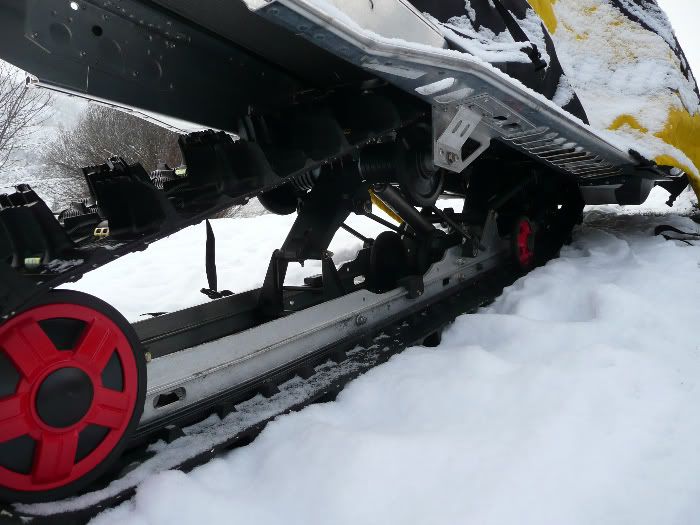Your confused alright...1st you don't have to be going 30 mph to lay a sled over. Most riders can lay there sled over just past engagement and not even doing 10 mph....2nd Your transfer weight is completely different from ski pressure and or how hard you choose to sweeze your throttle.
If theres no big differance between the 154XP and the 163XP than why does the 154XP come with a center spring rate that is 52# softer than the stiiffer 163XP ?
A sleds ability to transfer weight is a huge factor when riding deep snow or hillclimbilng. A sled that has it rear suspenion to stiff or the limiter strap to tight will always have a tendancy to plow through deep snow. Sled that plow through snow will always have slower trackspeeds than sled that are setup to plan & float on tgop of the snow.
The XP rear "scissor suspension" is no differant than my 2006 RT or my 2004 Rev. They all have 2 rear torsion, 1 rear shock and 1 center shock coil over...except the XP uses 1 limiter strap vs 2
Pic.#1 is the 2008XP rear scissor suspension pic #2 is the 2006RT1000 scissor suspension....whats the differance 1 limiter strap ? LOL
no. Did you just look at the parts or did you actually measure the distances in relation to the mounting points of the front and rear arms, shock length, compression and rebound damping, torsion spring position and cam positions, front shock mounting location and angle?......I could go on all day.
Again, mounting the lower front shock cross bar 2" rearward will have a profound effect on amount of mechnical force required to compress the spring which will require a different spring rate. Can you squeeze as tight with a set of needle nose compared to a set of vise grips? mechanical advantage is far greater on the vise grips based on pivot point. Just becuz the same parts are there, does not mean they are in the same location. Again, I don't have 2 sleds in front of me to measure the dimensions from the ZX chassis to the Rev to the XP so I cannot say for certain.
As for your idea that a sled with a stiff rear suspension or tight limiter strap will plow through snow is precisely the opposite of what is true. If the limiter strap is loose, the front of the skid sags and the approach angle increases, causing trenching and not floatation. If your statement is true, why have mountain riders been doing drop and rolls and sucking up the limiter strap for years to improve the approach angle? Have we been doing it wrong all along?
Have a look at some of the real mountain sleds built, specifically the very last picture in the 1160 ZX hillclimber build up which shows a great side shot.
http://www.emountainmagic.com/content.asp?ContentType=Product
Compare that approach angle to your XP.......that sled could have the shocks welded solid on it for the hardest suspension around and it would still float on the snow better than any XP. Floatation is based on approach angle.
As for the idea that any rider can flop their sled over at 10 mph, then why are we having this conversation? If it is indeed as easy as you say, why the need to bother changing it then? Why go to all the effort and expense of changing spring rates for a what, 3-5% increase in rideability? Seems like people are trying to make this far more complicated than it is if that is the case. As stated before, riders will have to adapt to this sled, not set it up like the last 15 they owned.
your turn.






